|
|
|
Sort Order |
|
|
|
Items / Page
|
|
|
|
|
|
|
| Srl | Item |
| 1 |
ID:
144114
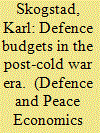

|
|
|
|
|
| Summary/Abstract |
This paper examines the determinants of national defence budgets in the post-Cold War era employing a spatial econometric framework. Using data for 124 countries over a 16-year time period, I examine spatial relationships in defence spending to investigate how countries account for the military spending of other countries when setting their budgets. Using specially developed weighting matrices, the regression results indicate that defence budgets are positively spatially correlated. These results provide support for the use of ‘external’ factors when examining defence budgets over this time period. The importance of a country’s spatial location when setting its budget is further examined through the identification of regions of high and low defence spending.
|
|
|
|
|
|
|
|
|
|
|
|
|
|
|
|
| 2 |
ID:
190922


|
|
|
|
|
| Summary/Abstract |
We argue that the stories told about the histories and nature of places, are vehicles for narrating race. Drawing on interviews with professionals and community workers in Butetown in Cardiff and Govanhill in Glasgow, we explore how they negotiated – and contested – racialized histories of place, constructing different versions or claims to belong. Drawing on Henri Lefebvre’s spatial concepts we explore this conceptualization through examination of the two areas that have distinct histories, and present experiences, of migration and racialization. In discussion of the accounts from the two distinct areas, we show that narratives of the past have a political resonance that shape accounts of current experiences of migration. Accounts of place are often related in relationship to comparisons with and narratives of other places and to global processes of trade and migration. Whilst these racialized narratives are contested, they also shape responses to social problems faced by communities.
|
|
|
|
|
|
|
|
|
|
|
|
|
|
|
|
| 3 |
ID:
079646
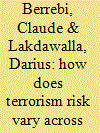

|
|
|
|
|
| Publication |
2007.
|
| Summary/Abstract |
We study the spatial and temporal determinants of terrorism risk in Israel, using a geocoded database of Israeli terrorist attacks from 1949 to 2004. In selecting targets, terrorists seem to respond rationally to costs and benefits: they are more likely to hit targets more accessible from their own homebases and international borders, closer to symbolic centers of government administration, and in more heavily Jewish areas. We also examine the waiting time between attacks experienced by localities. Long periods without an attack signal lower risk for most localities, but higher risk for important areas such as regional or national capitals
|
|
|
|
|
|
|
|
|
|
|
|
|
|
|
|
| 4 |
ID:
185592
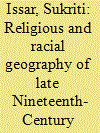

|
|
|
|
|
| Summary/Abstract |
The spatial separation of European colonialists and the local population was long seen as the defining feature of colonial cities. In recent years, the literature has moved toward a more ambivalent and contingent view of this spatial separation. This paper attempts to look beyond imagining the colonial city in terms of stark dualities or revisionist ambivalences, addressing both religious and racial separation. The paper analyses the street-level religious and racial geography of late nineteenth-century Bombay, using data from the 1881 Census. Results suggest moderate to high levels of racial and religious segregation in nineteenth-century Bombay at the street level, varying across groups, coupled with the existence of enclaves, and expressions of preference for segregation in diverse domains. The paper concludes that religion and race were meaningful social categories inscribed in urban space.
|
|
|
|
|
|
|
|
|
|
|
|
|
|
|
|
| 5 |
ID:
147317
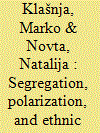

|
|
|
|
|
| Summary/Abstract |
An index of ethnic segregation conveys the extent of spatial mixing of ethnic groups, whereas an index of ethnic polarization and similar diversity measures show the overall balance between the groups. We present a game-theoretic model of conflict in which local success of one ethnic group encourages attacks by its co-ethnics in neighboring areas. Conditional on conflict breaking out, we find that for highly ethnically polarized societies, increasing ethnic segregation decreases the incidence and intensity of conflict. In contrast, in societies with low ethnic polarization, increasing segregation increases conflict. This is because segregation and polarization jointly determine the spread of conflict, an important channel that has been neglected previously. We find strong empirical support for model predictions in two very different conflicts: Hindu–Muslim riots in the 1980s and 1990s in India and the Bosnian Civil War from 1992 to 1995.
|
|
|
|
|
|
|
|
|
|
|
|
|
|
|
|
| 6 |
ID:
176725


|
|
|
|
|
| Summary/Abstract |
As the state of Oregon transitions to a low-carbon economy, households currently experiencing a high energy cost burden may be vulnerable to future energy price fluctuations. To identify areas susceptible to high energy burden, this study models household energy use intensity on a census-tract level in Oregon. Findings are compared with housing, racial, and sociodemographic characteristics to explore factors associated with high energy use. Finally, energy cost index is constructed and mapped to identify census tracts vulnerable to high energy burden for targeted program and policy development. Study results reveal that census tracts with higher level of energy use intensity have higher percent of older housing, low-income households, households experiencing energy burden, and populations of racial minorities and without high school diploma. This research advances our understanding of differences in energy consumption across diverse population groups and provides detailed information on energy use and energy cost burden for state-level policymaking.
|
|
|
|
|
|
|
|
|
|
|
|
|
|
|
|
| 7 |
ID:
120278
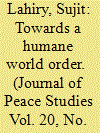

|
|
|
|
|
|
|
|